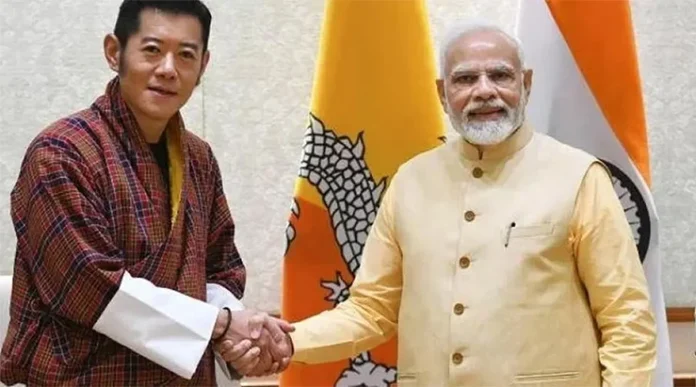On March 22, when Prime Minister Narendra Modi took a flight to Bhutan just two-days after the Ministry of External Affairs informed the cancellation of the Prime Minister’s state visit to Thimphu due to inclement weather conditions over Paro airport, it surprised all. It appeared that the visit would not take place before the parliamentary election as the Election Commission of India had announced dates for the polls, to be held in seven phases from April 19.
Prime Minister Modi, being the key campaigner of his party, offered no reason to anyone why he would undertake a visit to Bhutan any time before the highly important parliamentary election was over.
But then Modi, known for hard decision-making, did not disappoint his host, Bhutanese Prime Minister Tshering Tobgay. He reached Thimphu on the morning of March 22 – only four-days after the Bhutanese Prime Minister’s March 14-18 visit to India, indicating importance that New Delhi attaches to its partnership with the Himalayan country which is strategically located between two giant Asian powers, India and China.
Bhutan, which the Prime Minister Modi has visited twice earlier – in 2014 and 2019, conferred the visiting Indian Prime Minister with Order of the Durk Gyalpo, the highest civilian award of Bhutan. With this, PM Modi became the first foreign leader to receive this civilian award from the Himalayan country, which is feverishly wooed by China to settle its border dispute.
Bhutan-China Border Talks
Bhutan’s border discussions with China saw considerable progress under the previous Bhutanese government-led by Lotay Tshering. In early 2023, in an interview with a Belgian newspaper, he said demarcation of the Bhutan-China boundary would be settled at an early date.
In October 2023, the then Bhutanese Foreign Affairs and External Trade Minister Tandi Dorji went to Beijing to hold 25th round of boundary talks with Chinese officials. Later he told the media that the two countries are nearing the completion of the three-step roadmap, agreed upon by the two countries in October 2021.
PM Modi’s visit to Bhutan indicates importance that New Delhi attaches to its partnership with the Himalayan country, which is strategically located between two giant Asian powers, India and China
Indian Policymakers’ Wariness
This created an impression among Indian policymakers that if a settlement is reached between Bhutan and China, it could have strategic implications for New Delhi. China is pressuring Bhutan to let it open an embassy in Thimphu and concede territory in its West, where Doklam Plateau is situated. In return for Doklam, China is said to be ready to give up its claim in northern and eastern border areas with Bhutan.
Doklam lies close to India-Bhutan-China tri-junction and is critical for Beijing as it brings China closer to India’s border in a vulnerable location towards the 27-kms-long Siliguri Corridor or ‘Chicken Neck’ that connects India with its northeastern states.
To exert pressure on Bhutan, China has employed coercive methods, including building permanent structures within Beyul Khenpajong, which is sacred ancestral lands for many Buddhists, as well as for the royal Wangchuk family. In 2020, it laid claims to 650 sq kms of Sakteng Wildlife Sanctuary in Bhutan’s eastern district of Trashigang. It has not yet acknowledged the new Bhutan government-led by Tshering Tobgay.
Indian Message To China
Mindful of these developments, Prime Minister Modi undertook the two-day visit to Bhutan sending a clear message to China that India stands closely by Thimphu and that it cannot weaken a strong bond between the two close neighbours.
Along with Bhutan, China is increasingly facing tough challenge from India in eastern Ladakh and Arunachal Pradesh as New Delhi has militarised the border in these areas in matching proportion to Chinese troops’ deployment, while additionally 10,000 troops have been positioned to guard a 532 km stretch of border which separates China’s Tibet region with Indian states of Himachal Pradesh and Uttarakhand.
China is pressuring Bhutan to let it open an embassy in Thimphu and concede territory in its West, where Doklam Plateau is situated. In return for Doklam, China is said to be ready to give up its claim in northern and eastern border areas with Bhutan
Rubbing Salt Into China’s Wounds
However, India rubbed salt into China’s wounds when Prime Minister Modi visited Arunachal Pradesh on March 9 and inaugurated the strategically significant Sela Tunnel, situated at an altitude of 13,700 feet in West Kameng district, on the road linking Tezpur with Tawang.
As the country’s highest mountain tunnel, providing all-weather connectivity to the strategic Tawang, Sela tunnel will help India in quick mobilisation of troops even during winter when heavy snow fall makes movement towards Tawang or forward areas a bit treacherous.
Development of several infrastructure projects under the Border Area Development Programme in Arunachal Pradesh along with strengthening national and state highways and rail connectivity has given India strategic advantage in meeting any challenge from China in the northeastern state.
For the first time, the US also rapped over China’s knuckles as it recognised Arunachal Pradesh as Indian territory. The US State Department strongly opposed any unilateral attempts to advance territorial claims by China across the Line of Actual Control.
The US’s official statement on Arunachal Pradesh came a few days after the Chinese Defence Ministry reiterated its claim over Arunachal Pradesh, terming it as “Zangnan – an inherent part of China’s territory.” External Affairs Minister S Jaishankar, who was on a three-day visit to Singapore from March 23, rubbished China’s claim on Arunachal Pradesh, terming it “ludicrous”.
“This is not a new issue. I mean China has laid claim, it has expanded its claim. The claims are ludicrous to begin with and remain ludicrous today,” Jaishankar said during his just concluded three-day visit to Singapore.
China has employed coercive methods, including building permanent structures within Beyul Khenpajong, which is sacred ancestral lands for many Buddhists, as well as for the royal Wangchuk family
China’s Catch-22 Situation
Given India’s resistance to China at the Line of Actual Control with armed forces ready to teach Beijing a lesson, should it indulge in any provocation, President Xi Jinping apparently finds himself in an awkward situation.
Four years have passed, he can neither cow down India nor can he withdraw Chinese troops positioned in harsh conditions along the Himalayan borders. Twenty-one rounds of military-level talks have taken place between the two countries, but Depsang and Demchok continue to be friction points.
Writing for Nikkei Asia, Japan’s leading newspaper, Brahma Chellaney commented, “For four years, tens of thousands of Chinese troops have remained deployed in extremely harsh conditions along the Himalayan frontier. If Xi somehow came to an agreement with Modi about undoing China’s territorial encroachments, he would face questions about why he embarked on the aggression in the first place.”
India’s ace security expert further said, “The longer the standoff persists, the greater is the risk that Beijing turns India into an enduring enemy, a development that would weigh down China’s global and regional ambitions.”
Prime Minister Modi’s two-day visit to Bhutan has been full of symbolism and substance as this has led to further cementing of ties between the two countries as well as deepening of cooperation between them over their mutual security. “We agree to continue with our close coordination and cooperation with each other on issues relating to our national interests,” India-Bhutan Joint Statement issued during Prime Minister Modi’s visit, stated.
–The writer is a senior journalist with wide experience in covering international affairs. The views expressed are of the writer and do not necessarily reflect the views of Raksha Anirveda
–The writer is a senior journalist with wide experience in covering international affairs. The views expressed are of the writer and do not necessarily reflect the views of Raksha Anirveda






